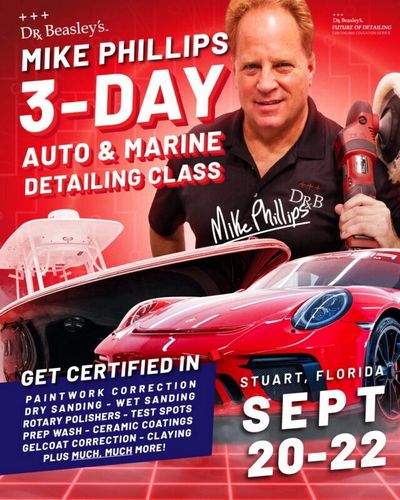- Admin
- #1
- Joined
- May 21, 2021
- Messages
- 1,680
- Reaction score
- 929
- Points
- 113
- Location
- Stuart, Florida
- Website
- themikephillipsforum.com
Teaching Car Detailing with Demo Hoods!
I used to teach car detailing classes using demo hoods, also called training hoods. There came a point when I transitioned to using actual cars to teach sanding.
Here's some old pictures from 2014 showing a collection of training hoods and trunk lids for my geek classes. There's a total of 9 hoods in the pictures below. Yancy was on a Skyjack Lift at the time and took these pictures.


Somewhere on the Internet, or a storage hard drive, I have a picture showing 16 demo hoods!
I no longer use any hoods in any of my classes, or test panels. Here's why. There's NO IMPACT and very little real-world learning when you train on flat surface about waist high. When you train on a real car, this has IMPACT. You have to learn how to sand and buff around,
Edges
Raised body lines
Side mirrors
Door handles
Antennas
Grills
Emblems
When sanding on an actual car, you have to learn how to focus on the task at hand and be careful. It simply has more impact and thus you learn more.
Mike
I used to teach car detailing classes using demo hoods, also called training hoods. There came a point when I transitioned to using actual cars to teach sanding.
Here's some old pictures from 2014 showing a collection of training hoods and trunk lids for my geek classes. There's a total of 9 hoods in the pictures below. Yancy was on a Skyjack Lift at the time and took these pictures.


Somewhere on the Internet, or a storage hard drive, I have a picture showing 16 demo hoods!
I no longer use any hoods in any of my classes, or test panels. Here's why. There's NO IMPACT and very little real-world learning when you train on flat surface about waist high. When you train on a real car, this has IMPACT. You have to learn how to sand and buff around,
Edges
Raised body lines
Side mirrors
Door handles
Antennas
Grills
Emblems
When sanding on an actual car, you have to learn how to focus on the task at hand and be careful. It simply has more impact and thus you learn more.
Mike
Last edited:














